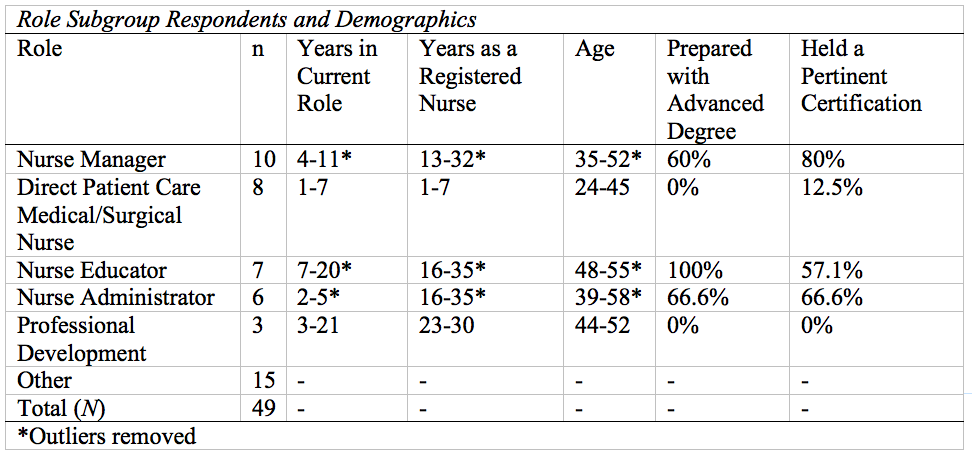Career Planning and Professional Development as a Strategy to Leverage Nursing Workforce and Organizational Needs
By: Alyssa S. Campbell, DNP, MBA, RN, CMSRN, RN-BC
Executive Summary
The job market for professional registered nurses (RNs) has been improving, yet remains vulnerable to the trials of attrition. Each time a nurse abandons his or her employer, it costs the organization about 1.5 times the RNs annual salary, or about $88,000 (Krsek, 2011). As national nursing attrition statistics show that 8.8 percent of nurses choose to abandon their roles and profession for many reasons, healthcare organizations should be compelled to act and consider creative strategies to prevent nurses from leaving their current roles, organizations, and the profession (Homberg, 2013). Limited evidence and tools exist to support or guide nurses on their professional growth and development journey to help maintain their engagement in the profession, despite overwhelming evidence suggesting that nurses highly value the application of their personal attributes to their jobs (Society for Human Resource Management, 2015). This article presents a solution to bridge the gap between nurses’ holistic needs while meeting organizational demands of providing quality patient care.
Introduction
Nursing turnover is undoubtedly a significant issue, as a multitude of factors influence nurses’ abilities and decisions to stay in their current roles. Over time, the focus of providing patient care has shifted from lengthy hospital stays towards offering services aimed at providing preventive care and decreasing the impact of acute and complex conditions. This means that while nurses were likely to work in typical hospital environments just a decade ago, the healthcare industry and delivery model have changed and now require nursing professionals to take on more outpatient and indirect care roles. With the shift in the methods and delivery of patient care, the variety of positions nurses can fill have been subsequently expanded.
Despite open opportunities, factors like the ability to apply a nurse’s personal skills and attributes to their role, along with variances in pay and need for flexible scheduling, account for just some of the reasons why nurses choose to leave their roles. Offering quick fixes like financial incentives are not enough to compel nurses to stay satisfied in their current roles, making pay increases a costly and short-lived solution. Because the turnover rate for registered nurses rests around nine percent while unemployment rates sit at less than two percent, we can conclude that nurses leave their roles but stay within the field. This means that nurses find it acceptable to leave their current roles as they continue to seek an increased sense of satisfaction and identity in future positions within the profession (Benson, 2012).

Not only do nurses consistently consider transitioning to new roles within the profession appropriate, they also desire the roles to be complimented by their skillsets. According to the Society for Human Resource Management, nurses express that their own personal skillset and personal characteristics should act as an essential component of each job, contributing to both the art as well as the science of nursing (2015).
Therefore, it is in the industry’s and healthcare organizations’ best interest to consider career planning as an essential standard of professional development to be provided to their nursing staff. Not only does the nurse engage in the ability to positively influence his or her career, but the organization stands the chance of investing within their current human resources to create a sustainable and satisfied workforce for the future.
Business Case
The following is a business case study outlining the cost impact of average attrition rates. A career planning and professional development strategy to promote the nursing profession while meeting the clinical needs of a healthcare organization could be implemented well below the cost of attrition.
Projected annual gross income: $1.39B
Estimated number of RN: 3,500
Estimated cost of attrition per RN: $90K
Rate of attrition: 9 percent (315 of 3500 RNs)
Cost of RN attrition per year: $28,350,000
Impact on bottom line: 2.04 percent (0.02039568)
Although nurses choose to leave their roles, organizations, and the profession for a variety of reasons, the overall organizational cost of attrition is simply too much to ignore. Close to half of nurses consider transitioning into different roles at least once a year, suggesting that opportunity exists to support nurses in their desire to pursue other facets of the profession. By providing adequate support and evidence-based recommendations, nurses may feel encouraged to pursue a role that meets not only their professional needs but their personal needs as well. In doing so, nurses may be more inclined to continue supporting their organizations while achieving his or her long-term career goals. Not only does the nurse benefit from career planning and professional development, but organizational benefits like cost-reduction in orientation programs, increased productive time, and nursing satisfaction can help support positive patient outcomes.
Pilot Study
In 2016, a qualitative pilot study was conducted to develop role-specific nursing profiles. The purpose of the study aimed to identify strengths, weaknesses, and interests as key characteristics that promote success across distinct nursing roles.
A total of 49 participants were involved in the study, however, subgroups of two or less respondents were removed from analysis due to lack of saturation. Identified roles with at least three respondents included: Nurse Manager (n = 10), Nurse Administrator (n = 6), Nurse Educator (n = 7), Professional Development Nurse (n = 3), and Direct Patient Care Medical/Surgical Nurse (n = 8). The study was conducted with the use of electronic surveys, and responses to open ended questions were analyzed utilizing Naturalistic Inquiry as methodologic framework. Inductive analysis was utilized as the primary strategy for response synthetization, allowing the emergence of several role-specific profiles.

Study participants were asked to describe the strengths, weaknesses, and personal characteristics that they attribute to success in their current roles. Analysis of the responses lead to the creation of five unique role profiles to support nurses in professional development and career planning by providing insight into the personal and professional demands of various nursing roles. Findings illustrated nuances between seemingly similar roles, and also distinguished generalized and distinct role identities.
With the use of job profiles, nurses who are interested in transitioning out of their current roles may efficiently realize their career goals and proactively seek a more satisfying nursing role by consulting established role profiles that outline background, knowledge, and other characteristics found to influence success. Both the nurse and the organization benefit from this strategy, as neither lose their investments of time, money, and resources.
Recommendations
Opportunity exists to leverage skills and experiences between nurse and organization, ultimately for the benefit of the patients. While nurses benefit from role and setting variety when seeking out new positions or careers, tools that assist in the identification of roles in which nurses can effectively apply their personal attributes and interests to yield personal success and satisfaction are yet to exist.
In conclusion, nurses, their mentors, and those involved in the professional development of nurses are urged to investigate role-specific determinants of success that have the potential to greatly impact nursing satisfaction, turnover, and the overall outlook of the nursing profession. Career planning and professional development is a proactive yet cost-effective approach to reduce attrition and burnout while improving long-term nursing satisfaction and quality patient care. The pilot study should be expanded to include quantitative research across the United States to assist in the development of an evidence-based aptitude tool to promote “right-fit” for the role; a trifecta solution (Patient+ Care Provider + Organization) that, in the future, may address issues of quality, safety, satisfaction, and investment.
Works Cited
Benson, A. Labor market trends among registered nurses: 2008-2011. Policy, Politics, & Nursing Practice, 13(4), 205-213. 2012.
Bureau of Labor Statistics, U.S. Department of Labor. Occupational outlook handbook, 2015-16 edition, Registered Nurses. 2015.
Homburg, V., Heijden, B., & Valkenburg, L. Why do nurses change jobs? An empirical study on determinants of specific nurses' post-exit destinations. 2013. Journal of Nursing Management, 21(6), 817-826. doi:10.1111/jonm.12142.
Krsek, C. Investing in nursing retention is a smart move in today’s economy. American Nurse Today, 6(4). 2011.
Society for Human Resource Management. Employee job satisfaction and engagement: Optimizing organizational culture for success. 2015. Retrieved from Link


